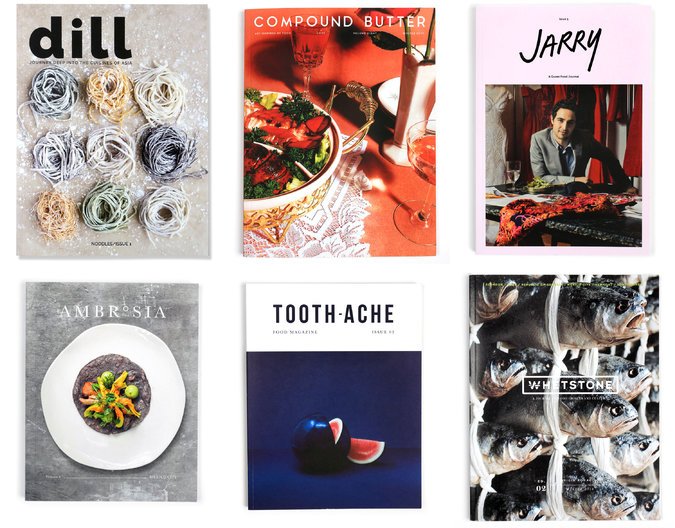Supported by
Food
A New Generation of Food Magazines Thinks Small, and in Ink
Shayne Chammavanijakul, a student at the University of Illinois at Urbana-Champaign, felt let down by the way some magazines depicted Asian cuisines — framed as alien, styled with visual clichés and oversimplified. So she started her own.
Last summer, between her freshman and sophomore years, she fried corn chips and rolled burritos at Chipotle, saving her wages to pay a few contributors. She gathered enough financial and editorial support from friends and family to print 10,000 copies of the first issue of Dill, packed with articles about noodle dishes, from Indonesian soto ayam to Filipino pancit puso.
“We present things in a way that isn’t sensational,” said Ms. Chammavanijakul, 20, whose family has roots in Thailand. “Food isn’t bizarre or cool or something you do on a dare. We have no interest in exoticizing it.”
At a time when traditional food magazines are shrinking and cutting staff, Dill is part of an unexpected groundswell across the country: a wave of small, sophisticated print magazines, produced on a shoestring by young editors with strong points of view and a passion for their subjects — from the subtleties of regional Thai home cooking to the intersection of food and queer culture.
Advertisement
Continue reading the main story
The last few years have brought new titles like Ambrosia, Compound Butter, Jarry, Kitchen Toke, Peddler and Kitchen Work. Kimberly Chou and Amanda Dell direct the Food Book Fair and Foodieodicals, an annual fair for independent magazines; Ms. Chou said the number of participating titles had increased to 30 last year, from about a dozen in 2012.
Continue reading the main story
Despite some off-putting names — like Toothache or Mold — many of these publications are beautiful and inviting, with ink-saturated pages filled with original art, and nuanced, complex stories you want to spend time digesting. Their cover prices are fittingly high, with many around $20, and a few don’t even bother to post their content online, focusing entirely on print.
Continue reading the main story
Staffs tend to be tiny (often just one or two people), as do circulations (150 to 15,000). But what these titles lack in size or legacy, they make up for in originality and ambition, often zooming in on stories that have been overlooked or misrepresented in traditional magazines, and publishing them on their own terms.
“A lot of the indie folks start out by making something they want to read, that tell stories they want told, that represent their own experiences or their friends’ experiences,” Ms. Chou said. “They aren’t necessarily pulling in the numbers of Bon Appétit or Saveur, but the thing is, they aren’t trying to.”
Ms. Chammavanijakul considers Dill’s small readership an advantage. “Other publications are limited because they cater to such a large spectrum of people,” she said. “With us, everything is unreservedly traditional. We don’t hold back.”
Nick Muncy, 29, a pastry chef who worked most recently at Coi in San Francisco, watched YouTube videos to teach himself the basics of programs like InDesign, which he now uses to lay out Toothache. He describes his twice-yearly magazine as made for chefs, by chefs. “I can use a food term and not have to explain it,” he said.
Slide Show|15 Photos
14 Food Titles to Know
14 Food Titles to Know
CreditPatricia Wall/The New York Times
Inspired by titles like Art Culinaire, in print since 1986, Mr. Muncy assumes that his readers — mainly professional cooks and others in the restaurant business — will have a base of food knowledge.
Almost all measurements in Toothache are metric, with no alternatives. And recipe instructions are technical and brief, with no hand-holding. “It’s like what you’d see in a professional kitchen,” Mr. Muncy said.
Advertisement
Continue reading the main story
Mac Malikowski, 30, brings the same kind of uncompromising specificity to Mouthfeel, his magazine about food and gay culture, which he produces in New York.
“Mouthfeel is a manifestation of the exact intersection of culture that I exist in,” said Mr. Malikowski, who sells up to 1,000 copies of each annual issue online, and at 10 retailers around the world.
When he started in 2015, Mr. Malikowski said he was looking to tell countercultural food stories, the kinds that weren’t already being told in mainstream magazines, with a more punk aesthetic. Mouthfeel has covered the naked dinner parties hosted by the San Francisco drag queen Juanita More, and profiled the New York chef Gerardo Gonzalez of Lalito.
Continue reading the main story Read the Original Article






























